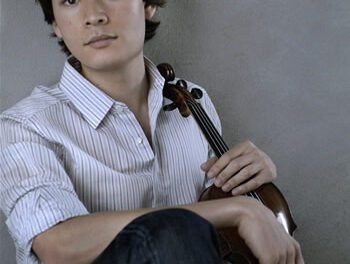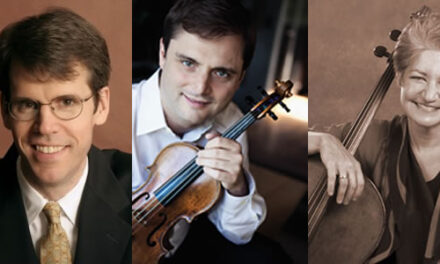 Carolina Performing Arts, located on the campus of UNC Chapel Hill, gave its final presentation of the 2020-21 season with a performance and conversation by the pianists Aaron Diehl and Clara Yang. Diehl is an award-winning jazz performer and recording artist. Among many other collaborations, he took part in a European tour with the Wynton Marsalis Septet. Yang is an associate professor of piano at UNC Chapel Hill. She has performed in many cities nationally and internationally as both recitalist and soloist with orchestra. Her solo album Folding Time was named by American Record Guide as one of the Best of 2016.
Carolina Performing Arts, located on the campus of UNC Chapel Hill, gave its final presentation of the 2020-21 season with a performance and conversation by the pianists Aaron Diehl and Clara Yang. Diehl is an award-winning jazz performer and recording artist. Among many other collaborations, he took part in a European tour with the Wynton Marsalis Septet. Yang is an associate professor of piano at UNC Chapel Hill. She has performed in many cities nationally and internationally as both recitalist and soloist with orchestra. Her solo album Folding Time was named by American Record Guide as one of the Best of 2016.
The event was introduced by Amy Russell, Director of Programming for Carolina Performing Arts; she is an articulate and well-spoken presenter and interviewer. There followed pieces by Philip Glass, George Gershwin, and Roland Hanna; the concluding music returned to Gershwin.
The first two pieces were taken from the Etudes by Glass (b.1937). Glass wrote two books of etudes, each consisting of ten, between 1994 and 2012. By the time of the second book, Glass had entered into a style which is as much romantic in flavor as minimalist. This was especially true of Etude No. 11, played by Yang. It has big, lush piano tone, wave-like figurations, and the punctuating presence of deep, dark octaves which are a key sound in the piece. Diehl played Etude No. 16, which features an ostinato in an irregular beat pattern, and a chordal texture in alternating registers above that. A brief middle section is more powerful and strongly reminiscent of Etude No. 11. Both pianists played with full tone and sensitivity to the changing sonorities, which is a central element in Glass’ music.
Following this was a discussion, interrupted by a significant technical glitch – the great assets of the streaming medium are nonetheless subject to drawbacks at times – of the Glass festival held at UNC in celebration of the composer’s 80th birthday in 2017. This was, it turns out, where Diehl and Yang first met and struck up the beginnings of their musical friendship.
Yang followed this with the Three Preludes by George Gershwin (1898-1937). Gershwin, the son of Russian-Jewish parents who immigrated to New York, became one of the most American of all composers. His musical theater songs are among the most enduring of any in the Great American Songbook. The catchy rhythms and rich harmonies of his tunes have placed them among the great jazz standards almost since they were written. And in the classic combination of jazz and concert music in his Rhapsody in Blue, Gershwin indelibly brought these genres together in a piece whose popularity has never faded since Gershwin himself premiered it as piano soloist in 1924.
The Preludes were written a couple of years after the Rhapsody, which had made Gershwin famous as a composer. They are miniatures, lasting all together as long as the single Etude No. 11 by Glass. They are as delightful as they are small, each distinct in character. Yang played the first one in restrained fashion. One wished for more exuberance in the rhythmic energy and sometimes-showy figurations. The second had appealing lyricism, but the wonderful blues in the middle could have stood out more in its character. The brief third piece was sheer fun and Yang seemed to enjoy the syncopations there.
This was followed by three Preludes, out of his set of 24, written by Roland Hanna (1932-2002) – or Sir Roland Hanna, courtesy of an ennoblement conferred upon him at age 38 by the king of Liberia. Hanna was an important jazz pianist who played with artists such as Benny Goodman and Charles Mingus, and was a member of the Lincoln Center Jazz Orchestra. He also served as a professor at Queens College in New York. His early training was significantly classical, and he retained substantial connection with that tradition.
The Preludes are in the latter mold (though not in the arrangement of the keys followed by previous composers). They show impressive ideas and range. Prelude No. 1 in B-flat begins boldly, a big-style introduction to a large set of pieces. It is fully romantic in style, with rich chordal writing. The No. 3 in B minor, is flowing, more water-like, suggesting Debussy, with pentatonic elements in the melody and fluid harmonic movement. The No. 10 in E is subtitled “Small Red Piano.” It begins with single high notes, which sound like they could be imitating a miniature piano. It then elaborates, romantic in style again. It is dreamy, the shortest of the three chosen for this performance. Diehl played these varied pieces compellingly, with obvious command, and caused this listener to want to hear more of the set.
More discussion followed, with interesting commentary on the music being heard. This was followed by the final and largest piece on the program, the Cuban Overture by Gershwin. Gershwin wrote it in 1932 following a trip to Havana from which he drew enormous musical inspiration. It was premiered in New York later that year for an audience of nearly 18,000 people – and several thousand more outside who were not able to get seats. Imagine: thousands in attendance at a concert devoted entirely to the music of Gershwin, the son of Russian immigrants, played by America’s oldest orchestra, the New York Philharmonic! That image by itself is enough to give a picture of how enormously renowned Gershwin, then just 34, had become.
Here the overture was heard as arranged for two pianos in 1944 by Gregory Stone. It is difficult, and it is a worthy addition to the quantitatively limited repertory for two pianos. It cannot begin to match the riotous colors of Gershwin’s large orchestra, but heard as a piece distinct from that original, it has definite merit. Its main drawback – hard to avoid – is the loss of much of the characteristic percussion in the orchestra. One could imagine, however, how much would be added if two pianists could bring even a single percussion player to be part of the arrangement. The rhythm would become immediately vivid.
The performance was successful, but also came over as careful as much as exuberant. That may be due to the realities of recording it virtually, with Yang having to coordinate her playing with the part pre-recorded by Diehl (there was detailed discussion of this prior to the hearing of the performance). One must salute the skill and dedication of these two artists undertaking this large and challenging piece under these conditions. And one should also credit the recording engineer, Adam Abeshouse in New York, who created the finished combination. Whatever the limitations, this piece gave joy and pleasure to the musical ending of the program.
Much was fine, but one could imagine the event being designed differently. The total musical time was just over 35 minutes, with the talk time being a little more. That took away from the leading position of the music. Rather much time was spent reminiscing about the Glass festival which took place four years ago. The same was true for the elaboration afterwards on virtual recording. Combined with the excellent performances and interesting parts of the discussion, it came over somewhat as an informal event with musicians who are friends chatting and playing music. Less talk and a single big central piece would have made it most excellent.













